Music of the spheres - the orchestral music of Pete Townshend
Pete Townshend has often described hearing incredible orchestral music in his head as a young child that he refers to as the “music of the spheres”. These early experiences with celestial music have helped inspire one of the greatest composers of our time.
Pete’s most famous contributions to the music world are his extraordinary rock operas. His story based songs are unified by themes and beautiful motifs that are more commonly found in classical music. While his greatest works were originally presented in a rock setting, orchestral music has been a heavy influence in Pete’s unique style of composing from early on, and his technique of incorporating classical ideas into traditional guitar based rock songs were groundbreaking back in the 60’s. His early song writing was influenced by classical music composers, and his musical mentor Kit Lambert encouraged Pete to explore grand ideas and themes, which Pete used to great effect in both his early pop songs and later in his longer form rock operas. In the late 70’s, Pete incorporated orchestrated music in many of his solo recordings, thanks to the help of his father-in-law Edwin Astley (famous TV and film composer), to create a wonderful orchestral backdrop to his stories. The music Pete composed as a young man and beyond is complex and intricate, full of fantastic musical themes that are loved the world over, and decades later sound as fresh and original as the day they were released.
Pete is currently working on transforming his famous story based rock pieces into full blown orchestrations that can be performed by orchestras and choirs for many years to come and will keep his music alive into the future. In June 2015, Pete released a fully orchestrated recording of his rock opera Quadrophenia, which was performed by the Royal Philharmonic Orchestra at the Royal Albert Hall in July.
The following is the history of Pete’s orchestral music and classical influences over the years, told primarily in his own words sourced from various interviews, diaries, and his autobiography.
The boy who heard music
 Original photo © Ethan Russell
Original photo © Ethan Russell
"I was one of those strange children that heard stuff when I was young, right through to the age of 12. I heard orchestral music that my friend the poet Ted Hughes said could have been what he called the music of the spheres. Literally: the sound of outer space resonating in some way. We lose the ability to hear this when we lose our innocence. Indeed, on one occasion I heard such music on the river Thames, which inspired some of the plot of Quadrophenia. For me, when I listen to music – particularly my own recordings – I tend to hear something different to anyone else." [Discussions Magazine May 27, 2015]
"On my first Isle of Man fishing trip, I had a fiasco with a huge trout and was consoling myself by playing harmonica in the rain. I got lost in the sound of my mouth organ, and then had the most extraordinary, life-changing experience. Suddenly I was hearing music within the music – rich, complex harmonic beauty that had been locked in the sounds I’d been making. The next day I went fly fishing, and this time the murmuring sound of the river opened up a well-spring of music so enormous that I fell in and out of a trance. It was the beginning of my lifelong connection to rivers and the sea – and to what might be described as the music of the spheres." [Who I Am autobiography 2012]
"As we swept past the Old Boathouse at Isleworth once again I began to hear the most extraordinary music, sparked by the whine of the outboard motor and the burbling sound of water against the hull. I heard violins, cellos, horns, harps and voices, which increased in number until I could hear countless threads of an angelic choir; It was a sublime experience. I have never heard such music since, and my personal musical ambition has always been to rediscover that sound and relive its effect on me. At the very height of my euphoric trance the boat ran up against the muddy shore at the troop’s hut. As it stopped, so did the music. Bereft, I quietly began to weep. I kept asking the other boys if they had heard the angels singing, but none of them even responded." [Who I Am autobiography 2012]
"Whenever we made a family visit to Horry and Dot’s, I got to see not only my beloved grandparents, but also my Aunt Tril. In her room was a piano, which became a real attraction for me, because it was the only piano in my life. After a time in her company I would always drift to the piano and—looking sideways to check that she was properly engrossed in her knitting, crochet work or a book—began to play. The instrument was never quite in tune, and I explored the keyboard until I found the combination of harmonics I was after. Then, I would repetitively play the same series of notes over and over, listening through the surface and deeply into what piano-tuners call ‘overtones’, the harmonics and resonances that all musical instruments produce as a characteristic of their timbre. One day at Trilby’s piano I found some chords which quickly sent me into another euphoric trance, this time the music that was releasing me was in my own head. My body buzzed all over and my head was full of the most complex and disturbing orchestral music, which in my own mind I was both hearing and, in a manner of speaking—because I seemed to be able to influence its movement and complexity—composing. ‘That was beautiful,’ said Tril, looking up. ‘Really, really lovely. You are a real musician.’ She was the first person ever to recognise my musical ability, to tell me I had musical talent." [Who He blog "Seventeen" March 7, 2007]
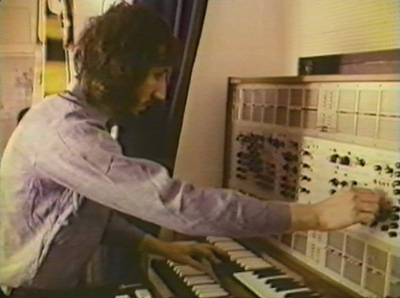
"There is a difference between the inspired composer and the skilled orchestrator. A good orchestrator can sit with sheets of manuscript and, as the arrangement develops, can read the notes and actually hear a phantom orchestra in his head. But an inspired composer hears music in his mind so complex, so diverting, that any attempt to write it down seems facile. What this kind of visitation produces in the subject is a desire to rediscover what has been heard before." [The Boy Who Heard Music chapter "I Heard Music" October 2, 2005]
"The music computer had landed in two forms. There was the Fairlight CMI, a synthesizer/sampler workstation beloved of New Romantic bands; by the time I started work on White City I had bought my own. The other system was the Synclavier, a digital FM synthesizer with a microprocessor-controlled sequencer. I realized these developments meant I would soon be able to compose and orchestrate very seriously, without the expense of using real orchestras or the barrier of working with orchestrators like Raphael Rudd or Edwin Astley. I found this incredibly exciting, although I have to add that nothing I’ve ever heard has surpassed what I heard in my imagination as a boy." [Who I Am autobiography 2012]
Orchestral and classical influences on Pete's work
"There was something else too that I had not thought about for a long time, my ability to create alpha-state music in my head, to go into a creative trance, to have musical ‘visions’. What revived this latter attribute after nearly six years of dormancy was hearing orchestral music again. The college ran lunchtime clubs dedicated to new jazz (Bebop), Dixieland, orchestral music and opera. It was played in the lecture theatre on a large high-quality speaker system. Often an enthusiast would make some remarks, or give a short unpretentious lecture, sometimes critical. I attended all of them. When I started to hear classical music again, this time being fully informed about what I was hearing, I realised I was already very well grounded. While Jerry Cass had shaved each morning upstairs in 22 Whitehall Gardens, I had—as a child between the ages of seven and eleven—heard on his blaring radio tuned to the ‘Third Programme’ of the BBC, almost all the fugues, symphonies and concerti of Bach, Brahms, Beethoven, Haydyn, Handel, Mozart and the like.
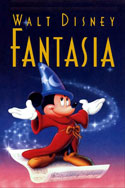 Then, when I had been about ten, at the Movietone News Theatre in Oxford Street I first saw the groundbreaking Disney animation feature ‘Fantasia’ which was projected with pioneering multi-channel sound. This film was my first exposure to true stereo sound. I had gone back at least ten times. Beautiful and powerful music literally intoxicated me long before I knew what intoxication was, and through this film with its complex and advanced audio recording I was to become a student and advocate of recording technology. At Ealing Art School’s lunchtime sessions, soon as a record began I could continue to sing it in my head." [Who He blog "Chapter 27" 2007]
Then, when I had been about ten, at the Movietone News Theatre in Oxford Street I first saw the groundbreaking Disney animation feature ‘Fantasia’ which was projected with pioneering multi-channel sound. This film was my first exposure to true stereo sound. I had gone back at least ten times. Beautiful and powerful music literally intoxicated me long before I knew what intoxication was, and through this film with its complex and advanced audio recording I was to become a student and advocate of recording technology. At Ealing Art School’s lunchtime sessions, soon as a record began I could continue to sing it in my head." [Who He blog "Chapter 27" 2007]
"I love the way surround sound in movies has revitalized the recording of large orchestras, it’s the best way to hear new orchestral writing. My favourite composer is John Williams, but I really like Thomas Newman too." [Pete's diary "The Wise One and the Grasshopper - Lesson 1" November 18, 2006]
"I’ve listened to a wide range of classical music throughout my life. Most Who fans will know that my mentor Kit Lambert introduced me to the English composer Henry Purcell, I was just 19 years old. I was greatly inspired by Purcell. Later I was intrigued by Wagner. He found a new way of presenting music on stage, and telling stories (which often had wide-ranging mythical and spiritual function)." [Corren.se July 5, 2015]
"For me, when I started on Tommy particularly, and then subsequently on Lifehouse, which is looking into a dystopian future of advanced and destructive and invasive and dangerous technology, then finally Quadrophenia, which was really just about a young man having a few bad days, I started to realize that I had an incredibly good foundation. Kit Lambert had introduced me to the work of Purcell and William Walton, and his dad had a box at the Royal Opera House, which I could pop into at any time, and in so doing I saw a lot of operas that I loved. I saw a few that I didn’t like. I like Boris Godunov now, but I didn’t like it when I first heard it. I wasn’t keen on very much Verdi, I didn’t like very much Mozart, but which I do now, but I didn’t then. I found it very hard to get past. The sound in the Royal Opera House is pretty crap, it sounds very dry and dead, but there was one opera that I saw which I think lies at the very heart of Quadrophenia and that’s a Benjamin Britten opera called Billy Budd. It really seemed to me… in a sense that was a post First World War story. A Suffolk fisherman takes a boy out to the sea and one day the boy dies and there is the influence also in between Benjamin Britten and his singer Peter Pears." [Interview with Tim Cooper 2015]
Rock operas
"I had talked about rock opera to everyone who would listen, and, though I'm sure that, as with guitar feedback, many others had the same idea around the same time, I hoped we'd be the first rock band with a major thematic work." [Who I Am autobiography 2012]
"One thing that might surprise people is that I believe [the rock opera form] gives me a chance to embrace the wonderful—but apparently limited—pop-rock song form more fully. A great rock or pop song can stand on its own. Its function is to grapple with whatever issue is on the table, but bring release, empowerment and mutual acceptance in the audience. So when you string a bunch of songs together to help tell a story, you are really just starting where we all spend most of our time in any case, in one of the many days of our lives. One way to appreciate our own ‘story’ is often to immerse ourselves in other stories. This is what art has always done I suppose." [Barnes and Noble interview May 15, 2015]
Early pop operas
"May 1966... Keith's best friend Ray Tolliday began to talk to me a lot about opera, and one day asked if I would help him write one. This turned out to be a joke, Gratis Amatis, which Ray said meant ‘free love’ in Latin. “Gratis Amatis I love Lionel Bartis” He wanted to play it to Kit for his birthday. When Kit heard it he laughed, but later suggested to me that Ray and I had really hit on something: he called it Pop Opera. I tried to develop Speedy’s Summer City idea, but couldn’t get very far with it. One of my songs worked out pretty well, Summer’s Gone. [...] I scratched out another ambitious, if rather daft, operatic story, which began life as Quinns, about four girls and a boy who nearly dies at birth. I tightened this up later into a single song with the working title of Quads, finally I’m A Boy. [...] In Soho at this time I wrote two other songs that I think were intended to be a part of another song-cycle about lunatics, misfits or people with unsound minds. They were King Rabbit and Lazy fat People. Happy Jack came a little later, part of the same idea. [...] A bigger idea was beginning to germinate: could I write a real opera? I began to contemplate the idea of creating something quite conventional. This was not a vanity. I thought it would be educational, would enrich and inspire me, and widen my powers as a composer. I gathered books and records I needed to begin a serious study of opera. I also began to scratch out more ideas for stories. One, which began as a few scribbled notes on a scrap of paper, suggested that in M, the instrumental I had written a while before, that later became Underture for Tommy, I had composed a very cohesive and powerful piece of dramatic programme music that would sound wonderful if it were orchestrated." [Who He blog "Sunbeams 2 - Operas in Soho" June 10, 2007]
A Quick One While He's Away - the mini-opera (released December 1966)
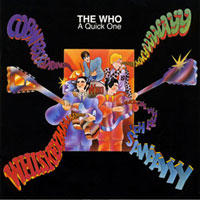 "Kit came to see me at my Soho studio and I played him a few works in progress, songs about rabbits, fat people and 'Gratis Amatis', the opera dedicated to Kit and our beloved mutual friend the composer Lionel Bart. Kit asked whether I could put together a more serious pop-opera piece with several distinct strands, perhaps based around 'Happy Jack'. [...] Quick, quick, quick. 'A Quick One' became our new watchword and the title of the new album when it was finally released. I scribbled out some words and came up with 'A Quick One, While He's Away'. This became known as the 'mini-opera', and is full of dark reflections of my childhood time with Denny." [Who I Am autobiography 2012]
"Kit came to see me at my Soho studio and I played him a few works in progress, songs about rabbits, fat people and 'Gratis Amatis', the opera dedicated to Kit and our beloved mutual friend the composer Lionel Bart. Kit asked whether I could put together a more serious pop-opera piece with several distinct strands, perhaps based around 'Happy Jack'. [...] Quick, quick, quick. 'A Quick One' became our new watchword and the title of the new album when it was finally released. I scribbled out some words and came up with 'A Quick One, While He's Away'. This became known as the 'mini-opera', and is full of dark reflections of my childhood time with Denny." [Who I Am autobiography 2012]
Rael (released December 1967)
"While I’m A Boy was being prepared for release as the new single, a task that took a mere two weeks in those days, we all took a holiday. I wanted guaranteed sunshine. I took my Dolly Bird to Caesarea in Israel. Her extreme miniskirts were a novelty and attracted a lot of interest, especially from the Arabs, several of whom I had to literally fight off to stop them assaulting her. The atmosphere was tense, especially in Jerusalem. When I got home I began to ask people I thought might know, what was going on in Israel. It quickly became clear that something awful was in the wind. One of my advisers moved from speaking about the growing tension between Israel and Egypt, to the emergent communist threat from China, a country with a population growing so fast – he said – that they would soon dominate the entire planet. From this came my idea for my first opera – which later became titled Rael. Briefly the plot deals with Israel being overrun by Red China. Over the next year I developed the story, and quite seriously planned to complete it as a major full-length through-composed operatic composition outside my work for the Who, even if it took a lifetime." [Who He blog "Sunbeams 3 - Arabs and Miniskirts" June 24, 2007]
"I hired a Bechstein upright piano from Harrod’s and installed it in the Dolly Bird’s bedroom. I wrote the first orchestrations there for Rael using a book called Orchestration by Walter Piston that I still refer to today." [Who He blog "The acidic cusp of 66 and 67 - and not a step further" July 6, 2007]
Tommy (released May 1969)
"It’s weird though, but when we were working on Tommy, Kit Lambert who was the producer, was the son of Constant Lambert, who was one of the people who started Royal Festival Ballet and the Covent Garden Opera House. He was the Director there for a long time. Kit Lambert really wanted Tommy to be a proper opera. If you listen to the recording, there is hardly any electric guitar on it, and that was because he always wanted to add an orchestra to it. And I fought, I really fought against that. Subsequently a classical or orchestral version of it was done by a guy called Lou Reizner, and I remember sitting and listening to it and thinking, this isn’t perfect, it is not precise to the music that I have written, which I think Rachel’s version of Quadrophenia is, but it made me realize that music is music. And actual fact what a rock band was, as my father once said, with a couple of guitars and amplifiers you are replacing an old fourteen piece band. You can make more noise, you’ve got less people in the band and of course the distortion was what created the harmonics the distortion of rock music was what created the richness of the sound, a couple of guys with a couple of distorted guitars are equal to a huge church organ." [Interview with Tim Cooper 2015]
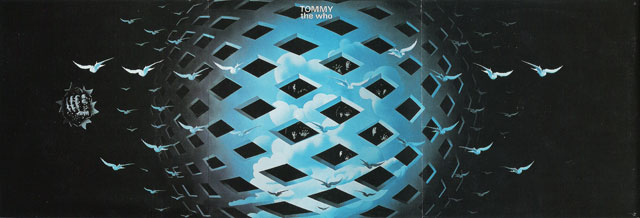
Quadrophenia (released October 1973)
"The story is about a few very difficult days in the life of a young person. We’ve all been there. What is unusual in this case perhaps is that the difficulty becomes a conduit for an explosion of passion, sexual frustration, anger and awkward love. My music seems to be especially good at expressing all this, and The Who’s band members were great at performing it. Audiences respond according to their ability or need to reconnect with this part of their growing up. Or they might simply look back sadly or fondly to the way they got through it all." [Amazon Front Row interview 2015]
"When I wrote the original songs it’s perhaps obvious I looked to Wagner for inspiration for some of the instrumental passages that were intended to evoke [the main character] Jimmy’s uneasy mix of paranoia and grandiosity. Elsewhere, where the music is lighter, I refer to Bach (especially his preludes) here and there. The overall story of Quadrophenia was inspired to some extent by one of my favorite English composers, Benjamin Britten. His opera Billy Budd is also about a young man enduring a difficult rite of passage, and is set by the seaside and on the sea itself." [Barnes and Noble interview May 15, 2015]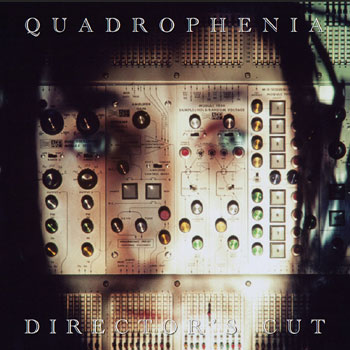 "I had synthesizer backing tracks, which I already developed for some other pseudo orchestral elements, violins and horns and oboe. John Entwistle could play almost any brass instrument with valves and he put on trumpets, baroque trumpets, tubas, sousaphones and all kinds of things to complement what I’d done. By the time we finished, the demos sounded like a massive pseudo orchestra in places." [Amazon Front Row interview 2015]
"I had synthesizer backing tracks, which I already developed for some other pseudo orchestral elements, violins and horns and oboe. John Entwistle could play almost any brass instrument with valves and he put on trumpets, baroque trumpets, tubas, sousaphones and all kinds of things to complement what I’d done. By the time we finished, the demos sounded like a massive pseudo orchestra in places." [Amazon Front Row interview 2015]
"I have been amazed at how Who music (and some of my own writing) lends itself to orchestral performance. Probably all music would sound wonderful played by a good orchestra. But there are a number of reasons why Who music lends itself. Keith Moon’s style of drumming was almost orchestral, more about decoration, flourishes and celebration than just keeping a beat. Who bassist John Entwistle was classically trained on trumpet and French Horn, so his work—especially on The Who’s Quadrophenia—encompassed a complete set of brass instruments, and he made his own arrangements. By the time The Who came to record the original album Roger’s singing was probably at its peak, and he pulled all the stops to make the words come alive. I was also adept at using analogue synthesizers, especially for orchestral emulation (having used them extensively on Who’s Next)." [Barnes and Noble interview May 15, 2015]
Pete's mission to orchestrate his rock operas
"I am keen to make sure that my most serious compositions are properly archived and notated (scored) in an accurate way. I want to make sure that musicians in the future can access these scores, and adapt them to various purposes, so that the music will continue to be played into the future. And of course what I want is for it to be played live in front of living audiences. I want the scores to enable performance from the top down, as-it-were: a full symphony orchestra with choir at the top, right down to simply piano-vocal charts, so that if a music teacher at a school wanted to get students to perform any of my operas, they could. Starting with full orchestra scores is a big project, especially as I can’t read music. (I can write it, using computers, but I have never been trained).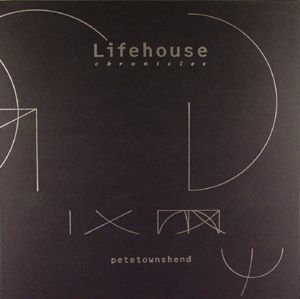 I started this work about 17 years ago. Mainly looking at my rock operas and mini-operas. Billy Nicholls, Sara Loewenthal and Rachel Fuller were the main protagonists in ‘Angelic Ceilings,’ a group I put together to begin this work. Our first joint project was Lifehouse Chronicles in 2000. Finally, in 2012 I decided to commission someone to start on Quadrophenia. I didn’t have to look far because by this time Rachel Fuller and I had lived together for a long time. Rachel was keen to take this on. By a coincidence, I had first met Rachel when The Who were rehearsing at a London studio for the 1996-1997 tour of Quadrophenia that grew out of the charity performance I organized in Hyde Park for the Prince’s Trust, of which I had been a patron and activist since 1982. On that occasion my very old friend Billy (Nicholls) had asked Rachel to orchestrate some of his solo work, and that’s how the connection was made." [Discussions Magazine May 27, 2015]
I started this work about 17 years ago. Mainly looking at my rock operas and mini-operas. Billy Nicholls, Sara Loewenthal and Rachel Fuller were the main protagonists in ‘Angelic Ceilings,’ a group I put together to begin this work. Our first joint project was Lifehouse Chronicles in 2000. Finally, in 2012 I decided to commission someone to start on Quadrophenia. I didn’t have to look far because by this time Rachel Fuller and I had lived together for a long time. Rachel was keen to take this on. By a coincidence, I had first met Rachel when The Who were rehearsing at a London studio for the 1996-1997 tour of Quadrophenia that grew out of the charity performance I organized in Hyde Park for the Prince’s Trust, of which I had been a patron and activist since 1982. On that occasion my very old friend Billy (Nicholls) had asked Rachel to orchestrate some of his solo work, and that’s how the connection was made." [Discussions Magazine May 27, 2015]
"I had decided like twenty years ago that one of the things I wanted to do was to make folios of all of the story based collections that I’ve done and it started with one which is called A Quick One, While He’s Away which is on The Who’s second album, so that was 1966. I did another one in 1967 called Rael, I then did Tommy, I then did one called Life House which was a failed concept album, I then did Quadrophenia, and as a solo artist I did White City, Ironman, Psychoderelict, and then for The Who last time another mini opera short form collection of songs called Wire and Glass. I wanted to see each of these pieces in a book for orchestra and that was what I wanted. And I started on that and met Rachel at a rehearsal room in London and it turned out she was an orchestrator and she was pretty, but she was an orchestrator. So I managed to track her down and asked her to do some work for me, and the first thing she worked on was Lifehouse Chronicles which was performed with a small chamber orchestra and a band at Sadler’s Wells. So I started just really wanting these books, you know I imagined myself as an old man: I’m in my country mansion, you know I’ve got a couple of dogs, and I go into my study and I’ve got this A Quick One, While He’s Away that was a good one, and then Rael that was a good one, and then right the way through and somebody would ask me the daft question: ‘why would you bother to do this.’ And I would say: ‘Because I think this is fabulous work and one day perhaps an orchestra like, you know, the London Philharmonic will perform it.’ So that’s how it came about. That’s really something that I wanted and I started to want it quite early in my career." [Classic Quadrophenia press release interview for 2015]
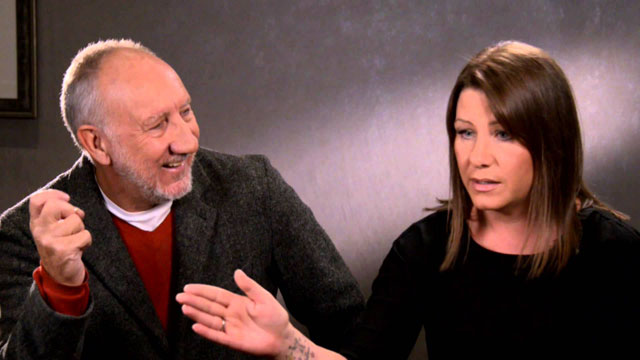
"When we [Rachel Fuller and I] first met, I was hoping that she would do some orchestrations for me. And she did some for a project called Lifehouse Chronicles, which went on at Sadler's Wells. She did 4 or 5 pieces for me for that. And then we ended up in a relationship. I wanted Tommy, Quadrophenia, The Iron Man, Psychoderelict, White City, a whole bunch of things I had done both in the Who and as a solo artist that had stories in them, including my mini-operas, A Quick One While He's Away, Endless Wire, and Rael, I wanted them to be orchestrated so they could be played by anybody. By a symphony orchestra, by a chamber orchestra, by a brass band, by a rock band, by a school orchestra, by a guy with a piano and choir. I wanted the music, that's all. The written music, the paper. I wanted it to be available online. So I asked her to start this [Classic Quadrophenia] about 3 years ago, and commissioned her to do it, gave her a fee to do it, which was in installments, and she enjoyed doing it. Hans Zimmer, who's a film composer, he does all the big block buster films, helped her put together a studio in which she could make demos of this stuff so I would hear these fantastic orchestral demos which were all done with samples and synthesis. One day Deutsche Grammaphone got to hear a couple of these demos and commissioned a proper recording. I'm really excited because having now done some of the recording, we've finished now, once he had done some of the recording with the Royal Philharmonic, I kind of sat back and thought, apart from anything else, the original music is genius, I always felt that if ever there was a moment of genius from me it was in Quadrophenia, and I don't mean that genius in the sense of braggadocio, I'm not bragging, I just mean it was just a coming together of a load of serendipitous things that created this fabulous moment for me as a writer. ... What was interesting about this, what was so special, was that Rachel did it right under my nose as it were. So she would do a bit and she would say "what do you think of it?", and I would say, "well that's great but that note shouldn't be in there." So, in a sense, the modality, the mood, the atmosphere, it's very, very faithful to the harmonics of the original piece. That is what I think is so good about working with my partner, is that we have been able to grow this very, very precisely. And Rachel's mission was never to add too much decoration, never to try and improve it, but rather to just turn it into an orchestral score. I don't think anyone else could have done that." [Radio interview BBC Radio 6 June 29, 2015]
Lifehouse Chronicles
The 6 CD Lifehouse Chronicles box set that Pete released from his Eelpie.com website on February 17, 2000 included one disc entitled Lifehouse Arrangements & Orchestrations that contained a variety of orchestrated songs, featuring the London Chamber Orchestra conducted by Harry Rabinowitz. The disc featured orchestral versions of Pete Townshend compositions: One Note - Prologue, Baba O'Riley, Hinterland Rag, Tragedy Explained, One Note - Epilogue. Also included are tracks from classical composers Purcell, Scarlatti, and Corette, including Purcell's entire suite of the Gordion Knot Untied. Produced by Pete Townshend and Billy Nicholls for Angelic Ceilings, orchestrated by Rachel Fuller and Sara Loewenthal.
A live performance of Lifehouse took place at Sadler's Wells in London on February 25-26, 2000, which was released on DVD and CD.
Classic Quadrophenia
Produced by Pete Townshend, orchestrated by Rachel Fuller. Recorded at Air Studios London October 21-23, 2014 by the Royal Philharmonic Orchestra conducted by Robert Ziegler and the London Oriana Choir. Starring Alfie Boe (Jimmy), Pete Townshend (Godfather), Billy Idol (Ace Face / Bell Boy), Phil Daniels (Dad). Released by Deutsche Grammophon in June 2015.
The album was launched with a World premier live performance at the Royal Albert Hall on July 5, 2015. See the Classic Quadrophenia concert page for more information.
"About three years ago, Rachel and I had a conversation about Quadrophenia and she said, “Can I have a go at it?” I called Hans Zimmer, who let Rachel do some tests at his studio in Soho. I loved it. I thought, “I can record five of these tracks with a proper orchestra and have them in my back pocket. It will cost about twenty thousand quid, but they’ll be great on a Best Of. I can play them to people, they’ll see what’s possible.” So we went to Air, we got the Royal Philharmonic. The conductor, Robert Zielger, had a lot of contacts. Suddenly, it became a proposition." [Uncut interview June 24, 2015]
"Rachel was my only collaborator, but she commissioned an assistant, Martin Batchelar, to whom she gave fairly free rein. I didn’t give Rachel that much scope for interpretation. To begin with I just wanted an orchestral representation of what was on The Who album, no extra songs, no frills, no diversions. Rachel was very happy to work faithfully in this way, and I gave her access to the Who multi-tracks from 1972-1973 so she could analyze each instrument or vocal part very accurately." [Barnes and Noble interview May 15, 2015]
"Rachel took the [original] multi-tracks, put them on computer and listened to the actual notes John played. They’ve been extrapolated and interpolated back into orchestral form. What was interesting to discover then was that Keith Moon was an orchestral percussionist! Very decorative, not really interested in the beat at all – he left that to the poor rhythm guitarist. So it’s there." [Uncut interview June 24, 2015]
"What made this project evolve from one that would have ended up with me holding a ‘folio’ (a book of written music) to a fully fledged recording, was that Rachel decided to do demonstration recordings as she went along, so I would be able to comment and approve what she and Martin were doing. I had asked my friend Hans Zimmer if he could guide Rachel in setting up a composition studio (of the kind Hans uses to write his film scores) and he gallantly invited Rachel to use some time in his London studio. The first track she worked on was Love Reign O’er Me, and it sounded spectacular. The conductor Robert Zeigler heard this synthesized demo track. He invited us to perform it with Jeff Beck and the BBC Concert Orchestra at Queen Elizabeth Hall in London. Suddenly what had merely been notes written on a score began to take a life as real music. Later, when Mark Wilkonson, the President of the classical label Deutsche Grammophon, heard it, he gave us a deal and recommended Alfie Boe to take the lead role." [Barnes and Noble interview May 15, 2015]
"The opening piano on “Love Reign O’er Me” was so accurately transcribed by Rachel that I could hardly believe it wasn’t me playing, but from there on it explodes into the most romantic and moving string writing, very much in the ‘English’ style. Alfie’s vocal is astonishing. But the songs I love the most are the ones that prove that it isn’t only rock‘n’roll that can rock: “I’ve Had Enough” and “Dr Jimmy” are both huge blockbuster performances with every instrument in the orchestra getting in on the act, and the effect is literally stunning. The RPO can really rock. With respect to our fans, I asked Rachel to try her best to retain the flourishes and details from the original album, and because Keith Moon and John Entwistle were so dramatic and orchestral in their methods, I believe it worked. With Quadrophenia it also helped that she had the very simple blueprint of my analogue synthesizer emulations of strings and brass." [Amazon Front Row interview 2015]
"The most wonderful surprise was seeing the way orchestral musicians threw themselves into playing this music. The last orchestral sessions I had done had been a while back, and so much has changed now for orchestras. They are challenged all the time, not only by the demands of the usual repertoire like Brahms, Beethoven and Wagner, but also by complex and highly rhythmic and explosive film scores written by the likes of Hans Zimmer. So they only needed a few takes to get the music right. Indeed, it sounded right first time." [Barnes and Noble interview May 15, 2015]
"I was encouraged by the fact that a few people I spoke to who ran orchestras, particularly around the U.S. but also in the U.K. and in Europe, were really excited about the idea of having something like Quadrophenia available for large orchestras. They all said that the subscription audience for orchestras was getting into difficulty because the new music that's being written by modern composers is very radical, generally. It's not easy on the ear. So having something that sat in the middle between the established repertoire of Bach, Wagner and Mozart and the more radical stuff by contemporary composers, that it would help them. I think they're hoping that they will play this and bring people into the symphony hall who wouldn't otherwise go, and it might open up a world for them. So there was a lot of encouragement to see this through. [The Royal Philharmonic musicians] seemed so worldly about it all. They take all this stuff in stride, so when we put Quadrophenia in front of them and they realize that they could have fun with it and they could play it and really bring it to life, they started to get excited about the idea of playing it, and the fact that it would, I suppose, give them a way of jacking into a completely new audience. Some of those tracks on the album are the first take -- not all of them, but some of them are." [Billboard interview June 10, 2015]
Orchestral work with Edwin Astley
"My ex-wife Karen Astley’s father was Edwin Astley, who was a film and TV composer. Very much like my own musician father and Kit Lambert, he was against any kind of snobbery in music – especially the classical world where the snobbery tends to be in the audience rather than the musicians and conductors. One day we decided to start a project together. Edwin had scored “Street In The City” for me, for the Rough Mix album I did with Ronnie Lane in 1977, and that was the style we were shooting for. Kit Lambert was meant to be producing. I’m afraid to say that Kit’s condition was even worse than it had been when I invited him to co-produce Q with me in 1973, so the project stuttered to a halt. Max Hole, now Chairman of Universal Records in Europe, has been pressing me to do an album like this, and I may consider it." [Discussions Magazine May 27, 2015]
Street in the City (released on Rough Mix 1977)
"It's guitar and voice, essentially, and on top of it is super imposed, a orchestral arrangement. The conception of the orchestral arrangement is particularly interesting because it is definitely not the kind of thing which I would ever come up with say, if I did something on the synthesizer. And that is because I haven't got the skill of the man who did the arrangement, who is actually, coincidentally my father-in-law. We are a family butcher you know <laughs>. I asked my father-in-law to do it, Ted Astley, who's been an orchestral arranger and film music writer of great success, in this country anyway, for many years. He put this arrangement together ever so quickly, and it’s a double string orchestra thing, with a large string orchestra and 6 big basses, and stuff. And I actually sat down with the orchestra and played through on the guitar, which was a really good experience. I haven't done that since Lou Reizner's Tommy, play with an orchestra. But it's not really that unique. Whenever you write a song, you tend to go through it in your head a various number of ways, and one of those ways might be thinking about how it would sound with a bloody great orchestra behind it. But I think it stands out, because it's more of a cooperative effort musically then anything I have ever done. I mean I have contributed the music and the song, and Ted Astley has really contributed a very sort of innovative arrangement around it. An impressionist piece. I paint pictures with using the words, but Ted paints more vivid pictures using the orchestra. I've actually thought about doing a complete album of stuff like this with Ted, because Street in the City has attracted so much attention." [Radio interview December 1977]
The Ferryman (recorded September 1978, released on Another Scoop 1987)
"This song was written for an amateur production of SIDDHARTHA at Meher Baba Oceanic Center during the opening celebrations in June 1976. Ted Astley later composed this absolutely stunning impressionistic orchestral setting for my simple, droning, open-tuned guitar. The lyric tells of Siddhartha's first meeting with the ferryman who is to become his spiritual master. The song closes as the ferryman explains that Siddhartha must replace him and learn his art of selfless service. (SIDDHARTHA is a short novel by Herman Hesse.)" Instruments: Gibson J200 (strung and tuned as in PRAYING THE GAME), large string section, woodwinds, percussion.Venue: Abbey Road Studio 1, London. Engineer: John Kurlander, Executive Producer: Kit Lambert. [Another Scoop liner notes 1987]
Praying The Game (recorded September 1978, released on Another Scoop 1987)
"This song was written in Cornwall in 1976. a long hot summer. I wrote STREET IN THE CITY (which appeared on ROUGH MIX the album I recorded with Ronnie Lane) at the same time. I wanted to record a complete album of similar pieces. The orchestration is by Ted Astley." Instruments: Gibson J200 with open tuning and high strung on both low E and A strings to produce the lopsided arpeggios, large string section, woodwinds, percussion. Venue: Studio 1 Abbey Road Studios, London.Engineer: John Kurlander, Executive Producer: Kit Lambert. [Another Scoop liner notes 1987]
Brooklyn Kids (recorded September 1978, released on Another Scoop 1987)
"I had a nasty vision one sunny afternoon – a beautiful girl walked past my studio window in a white dress. Behind her walked a young black kid; hip and hungry. Their relative states of self-absorption produced the idea of the rape of a lonely girl by a lonely man. The piano demo was enhanced by a beautiful orchestral arrangement by Ted Astley (my father-in-law)." Instruments: Bosendorfer piano, large string section, woodwinds. Venue: piano and voice at Home in Berkshire. Orchestra at Abbey Road, London. Engineer: John Kurlander, Executive Producer: Kit Lambert. [Another Scoop liner notes 1987]
Football Fugue (recorded September 1978, released on Another Scoop 1987)
"Ted Astley composed this track over which I wrote the lyric. It reminded me of an orchestral battlefield. With the musicians wearing big heavy boots. Hence the analogy with football and hooliganism" Instruments: large string section, percussion. Venue: Olympic studios, Barnes. Engineer: Glyn Johns. [Another Scoop liner notes 1987]
I Like It The Way It Is (recorded 1978, released on Scoop 3 2001)
"Jon Astley thought he could hear wow and flutter on this but it is actually the action of an Antares autotune device I used to try to tidy up the vocal. This orchestral piece was one of a group already featured on Another Scoop, and is the only one not released. The others were 'Brooklyn Kids', 'Praying The Game' etc. Ted Astley arranged the orchestra which was recorded in 1978 by Glyn Johns at the incredible and wonderful Olympic Studios before Richard Branson brought it and turned it into a Japanese airport waiting room with microphones." [Scoop 3 liner notes 2001]
Odds and sods - other orchestral work
Wired To The Moon (recorded 1997, released on Scoop 3 and petetownshend.com 2001)
"On December 11th last year I started work. The first track logged (though not the earliest piece I have) was recorded at Midnight on 12th January 1997. It is thus - using a reverse two digit code for year/month/day - called '970112'. It has a vocal line on it, I sing :".....I'm wired to the moon....". So I've called the track WIRED TO THE MOON. What I've done is run a MiniDV camera in my studio as I tidy up, prepare, undergo delays, and then edit and mix this first track. It has come out quite well. It's a powerful orchestral piece, a little rambling. I wasn't feeling all that well when I sat down to record it, and kept muttering about having experienced some heavy dreams at the time." [Pete's diary "The train arriving" January 5, 2001]
"This is quite typical of the kind of piano driven orchestral writing I've been doing for last few years. Some of you will know that I used orchestrators to write out the parts for the music I wrote for The Lifehouse BBC play in late 1999. This is the kind of piece my orchestrating collaborators would be presented with for analysis, not always with a sketch score. Both Rachel Fuller and Sara Lowenthal are good at analysing the harmonic structure of my writing, and while they are around I will not bother to write the dots myself. (I should add here that in some cases Rachel and Sara contributed a lot more than mere transcription. They are both terrific composers in their own right, and their detailed work can often make or break an orchestral recording). Keith Grant, the orchestral engineer on the Lifehouse sessions, calls this kind of thing 'pfaffing around with synthesizers'. But nobody does it quite like me, unless they are Thomas Newman writing for a Hollywood movie and getting paid a million dollars." [Pete's diary "Wired To The Moon" January 12, 2001]
I've Had Enough - orchestral overdub arranged by Raphael Rudd (released on petetownshend.com 2001)
"[Here] is a recording from the studio floor of the rather out-of-tune orchestra overdubbing some invigorating stuff for the Quadrophenia film soundtrack. These strings were not used in the movie. Recently there has been talk of a release of the movie on DVD with a new 5.1 surround sound mix. I started to look for additional stuff and found this wonderful piece of writing by Raphael Rudd." [Pete's diary "Heat, Dust and Lust mp3" May 12, 2001]
Scarlatti (unreleased 2003)
"The orchestral session here is an audophile recording I've made in purist 5.1 for DVD-A and SACD release. It features the London Chamber Orchestra who played on the Sadler's Well's concert and the Lifehouse Chronicles orchestral CD. The Sadler's Wells DVD won an award for Surround Sound. The Oceanic studio here is one I've had since 1976 - it began life as a center for Meher Baba and spent some of its time subsequently as a film studio. Now I use it for recording and of course for events for my web site. For this session I created a system to fly artificial reverberation and echo into the studio so that the musicians would feel as though they were playing in a concert hall. We used a very high quality system based around several units provided by the sponsors of the last Who tour - JBL (owned and distributed by Harman-Kardom). The reverb was generated by several mikes spread throughout the orchestra, mixed and fed into a Lexicon reverb unit. The outputs of that were fed into a seven channel pre-amplifier (also made by Lexicon) seven channels were 'synthsized' creating a delicate but expansive echo effect and thence fed to seven JBL 'Tik' speakers - two of which were placed above the orchestra's heads to give a feeling of height. The amplifiers used are also made by JBL. To record the orchestra I used a British microphone called the 'Soundfield' mike. This mike outputs four cleverly encoded channels that can later be decoded and arranged as the six channels for 5.1. I recorded these channels to ProTools HD at 192Khz.
The music is from Scarlatti. He wrote sonatas and fugues, principally for Harpsichord. I felt that some of them would sound beautiful if arranged for chamber orchestra (I included two sonatas on the Lifehouse Chronicles). This time I commissioned Rachel Fuller to orchestrate another twelve. Some of them are more successful than others - Scarlatti's gift was not as abundant as Bach's, but he did know how to compose powerfully strident pieces for the harpsichord, an instrument with little dynamic range. Orchestral translations of harpsichord works introduce dynamics that can sometimes distract from the composer's original intentions. We were careful not to overdo the dynamics with over-emotional readings. The session was a great success. The Surround Sound effect from the Soundfield mike is solid as a rock, and you can really feel the intimacy of the studio, but the airy space generated by the artificial echo. Some of Scarlatti's writing crosses boundaries: at times it is Italianate Baroque, as it should be. At others it is slightly Germanic and dark: the Fugues are often quite aggressive. Then there are segments when you can hear an almost pastoral English sound similar to that of the British composers of the 20th Century like Grainger, Britten and Bax. I was really pleased with the session and I hope to get it released very soon.The production was for Angelic Ceilings - a company I formed for Lifehouse Chronicles to record aspirational works - in other words to finish grand and adventurous 'serious' music projects I have the money and vision to start, but not the stamina or qualifications to properly finish. Billy Nicholls arranged the session, and Sara Lowenthal wrote out the parts and assisted in the session." [Pete's diary "Scarlatti" March 27, 2003]
Trilby's Piano - (released on Endless Wire 2006)
"Recording strings today was really enjoyable. I had knocked up a string orchestration on the Sibelius computer programme for my song Trilby's Piano and scored it for about 35 strings. Rachel re-arranged it for a string quartet, with some overdubs, and today we recorded it with a single stereo ribbon mike in my home studio, with the smallest dogs running in and out. Rachel is pretty classy at this kind of thing and really made it all seem very transparent." [Pete's diary "We've finished recording" May 26, 2006]
"She has skills I do not have, and may never have, and I have skills she needs to learn. But one thing I was able to do for the first time on this Who record was to confidently orchestrate a string section for one of my songs (Trilby’s Piano) and fix the players and record it without any adaptive work from an outsider. Rachel checked my work, added some dynamics here and there, and supervised the musicians on my session. Without her help I would have lost control." [Pete's diary "Grasshopper 5 - Who washes the dishes?" November 21, 2006]
How Can I Help You (released on Truancy 2015)
“I began this recording with an acoustic guitar, added drum loops and breaks (using a software program LIVE) then Gretsch and Rickenbacker 12-string guitars and John Entwistle’s hybrid Thunderbird Fender Precision bass. My rough string orchestration was replaced by the brilliant Martin Batchelar who usually works as Rachel’s orchestral collaborator.” [Truancy liner notes 2015]
Orchestrated Who
Lou Reizner's orchestrated Tommy (released October 1972)
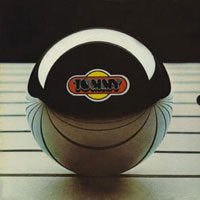 Produced by Lou Reizner, recorded by the London Symphony Orchestra with the English Chamber Choir, conducted by David Measham and arranged by Will Malone. The album was launched at a live performance on 9 December 1972 at the Rainbow Theatre, London, with The LSO, The ECC, The Who and an all star cast featuring Rod Stewart, Ringo Starr, Steve Winwood, Merry Clayton, Richie Havens, Sandy Denny, Maggie Bell, Graham Bell, Richard Harris. Read a review of the Rainbow show from Rolling Stone.
Produced by Lou Reizner, recorded by the London Symphony Orchestra with the English Chamber Choir, conducted by David Measham and arranged by Will Malone. The album was launched at a live performance on 9 December 1972 at the Rainbow Theatre, London, with The LSO, The ECC, The Who and an all star cast featuring Rod Stewart, Ringo Starr, Steve Winwood, Merry Clayton, Richie Havens, Sandy Denny, Maggie Bell, Graham Bell, Richard Harris. Read a review of the Rainbow show from Rolling Stone.
"Around the time of Ken Russell’s Tommy film, just before that there was an orchestral version of that, produced by a guy called Lou Reizner, with a star cast, Peter Sellers, Rod Stewart, and a bunch of other people, who sang the roles." [BBC Radio 6 interview June 29, 2015]
Daltrey Sings Townshend - A Celebration: The Music of Pete Townshend and The Who (released 1994)
Roger Daltrey put on a charity show featuring orchestrated versions of Pete Townshend's songs performed by the Juilliard Orchestra at Carnagie Hall on 23-24 February 1994 to celebrate his 50th birthday. Pete made a special guest appearance performing And I Moved and Who Are You. Roger later went on to tour the production around the US in fall 1994. Produced by Richard Flanzer and Bob Ezrin, arranged and conducted by Michael Kamen. Band: Roger Daltrey, John Rabbit Bundrick, Jon Carin, Jody Linscott, Pino Palladino, Phil Palmer, Simon Phillips, Billy Nicholls, Cleveland Watkiss. Special guests: Pete Townshend, John Entwistle, The Chieftains, David Sanborn, Linda Perry.
"Roger commissioned his own orchestrations in 1994 for a solo tour, and I have to say I was inspired to hear what he achieved. " [Amazon Front Row interview 2015]
Who's Serious - Symphonic Music of The Who (released February 10, 1998)
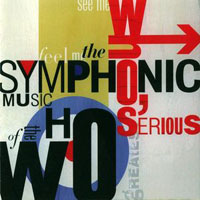 Produced by Jon Astley, co-produced by Billy Nicholls, recorded by the London Philharmonic Orchestra conducted by Peter Scholes at George Martin's Lyndhurst Hall Studio in London. Songs: Overture, I Can See For Miles, Pinball Wizard/See Me Feel Me, My Generation, Dr. Jimmy, Baba O'Riley, 5:15, Love Reign O'er Me, Who Are You, Listening to You. Band: Billy Nicholls: musical director, Zak Starkey: drums, Simon Townshend: guitar, Geoff Whitehorn: guitar, Phil Spalding: bass, John 'Rabbit' Bundrick: piano & organ, Jody Linscott: percussion, Peter Gordeno: keyboards. Choir: Jan Wilson, Simon Townshend, Billy Nicholls, Alistair Gordon, Steve Butler.
Produced by Jon Astley, co-produced by Billy Nicholls, recorded by the London Philharmonic Orchestra conducted by Peter Scholes at George Martin's Lyndhurst Hall Studio in London. Songs: Overture, I Can See For Miles, Pinball Wizard/See Me Feel Me, My Generation, Dr. Jimmy, Baba O'Riley, 5:15, Love Reign O'er Me, Who Are You, Listening to You. Band: Billy Nicholls: musical director, Zak Starkey: drums, Simon Townshend: guitar, Geoff Whitehorn: guitar, Phil Spalding: bass, John 'Rabbit' Bundrick: piano & organ, Jody Linscott: percussion, Peter Gordeno: keyboards. Choir: Jan Wilson, Simon Townshend, Billy Nicholls, Alistair Gordon, Steve Butler.
Credits
Produced, researched and written by Carrie Pratt
Special thanks to Ethan Russell!
